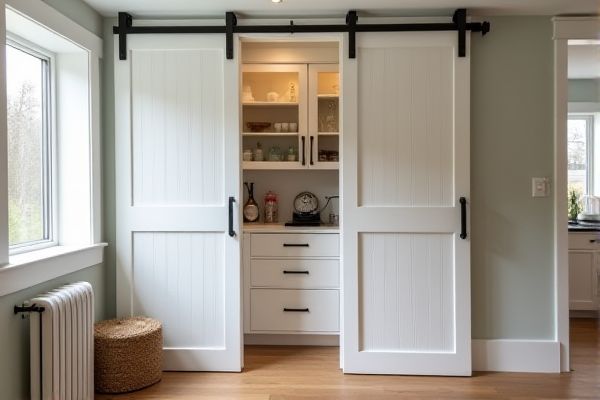
Sliding pantry doors save space by gliding along a track, making them ideal for narrow kitchens where room is limited, while hinged pantry doors offer a traditional design with wide access but require clearance to swing open. To discover which option best suits Your kitchen layout and style, continue reading for a detailed comparison.
Table of Comparison
| Feature | Sliding Pantry Doors | Hinged Pantry Doors |
|---|---|---|
| Space Efficiency | Save space; doors slide sideways, ideal for small kitchens | Require clearance to open outward; need more floor space |
| Accessibility | Partial opening limits full access; slide to one side at a time | Full door swings open; easier full access to pantry shelves |
| Installation | Requires track system; moderate installation complexity | Simple hinges; easier and quicker to install |
| Maintenance | Track can accumulate dirt; periodic cleaning needed | Hinges may need lubricating; less prone to debris issues |
| Design & Style | Modern and sleek look; fits minimalist designs | Classic appearance; wide variety of door styles |
| Cost | Generally higher due to hardware and installation | Usually lower; simpler hardware and installation |
Introduction to Sliding and Hinged Pantry Doors
Sliding pantry doors save space by gliding along a track, making them ideal for tight kitchens where swing clearance is limited. Hinged pantry doors offer a traditional look and full access to the pantry interior, swinging open on side-mounted hinges. Both options come in various materials like wood, glass, and metal, allowing customization based on kitchen design and functionality needs.
Space Efficiency: Sliding vs Hinged Pantry Doors
Sliding pantry doors maximize space efficiency by gliding along the wall, eliminating the need for clearance space required by hinged doors that swing outward. Hinged pantry doors demand more room to open fully, potentially obstructing adjacent cabinetry or pathways in compact kitchens. For small or narrow spaces, sliding doors provide a seamless solution that maintains accessibility without compromising floor area.
Aesthetic Appeal and Design Versatility
Sliding pantry doors offer a sleek, modern aesthetic that maximizes space and allows for seamless integration with contemporary kitchen designs. Hinged pantry doors provide classic appeal with greater design versatility, including the option for decorative panels or glass inserts that enhance traditional or transitional styles. Both door types can be customized with various finishes and materials to complement the overall kitchen decor.
Installation Process: What to Expect
Installing sliding pantry doors typically requires mounting a track system at the top of the pantry opening and ensuring it is level for smooth operation, making it a moderate DIY project that often demands precise measurements and specialized hardware. Hinged pantry doors involve attaching hinges directly to the door frame and aligning the door for proper swing clearance, which can be simpler but may require adjusting door alignment over time to prevent sticking. Both installation processes benefit from using quality tools and hardware to ensure durability and ease of use, with sliding doors offering a space-saving advantage and hinged doors providing a more traditional aesthetic.
Accessibility and Convenience
Sliding pantry doors maximize accessibility by allowing full access to shelves without requiring extra clearance space, ideal for tight kitchens. Hinged pantry doors offer straightforward convenience with a wide opening but need sufficient room to swing open fully. Sliding doors enhance efficiency in small areas, whereas hinged doors provide a traditional feel but may obstruct nearby movement or cabinetry.
Cost Comparison and Budget Considerations
Sliding pantry doors typically cost more upfront due to specialized hardware and installation requirements, while hinged pantry doors generally offer a lower initial price and simpler installation. Budget considerations should include maintenance costs, as sliding doors may require occasional track cleaning and adjustments, whereas hinged doors may need hinge replacements over time. Evaluating total cost of ownership alongside space constraints helps determine the most economical choice for your pantry.
Maintenance and Durability
Sliding pantry doors require less frequent maintenance due to fewer exposed hinges and hardware, reducing the risk of wear and tear. Hinged pantry doors often need regular lubrication and tightening of hinges to maintain smooth operation and prevent sagging. In terms of durability, sliding doors typically experience less structural stress since the door glides along a track, while hinged doors endure repetitive swinging motion that can weaken the frame over time.
Safety Factors for Kitchens
Sliding pantry doors reduce the risk of accidents in tight kitchen spaces by eliminating door swing interference, which is crucial in high-traffic areas or homes with children. Hinged pantry doors, while traditional, can pose hazards if left open, obstructing pathways and potentially causing collisions. Choosing sliding doors enhances kitchen safety by providing smoother access and minimizing obstruction, essential for busy or compact kitchens.
Customization Options and Materials
Sliding pantry doors offer a wide range of customization options, including various track styles, panel designs, and finishes that maximize space efficiency in smaller kitchens. Hinged pantry doors provide versatility in material choices, from solid wood and glass inserts to metal frames, allowing you to match your kitchen's aesthetic with traditional or modern styles. Your choice depends on the desired functionality and design flexibility, as sliding doors excel in compact areas, while hinged doors allow for broader material selection and detailed craftsmanship.
Final Verdict: Choosing the Best Pantry Door for Your Home
Sliding pantry doors save space and provide a sleek, modern look, ideal for smaller kitchens or tight areas where maximizing room is essential. Hinged pantry doors offer easier full-access to pantry interiors and come in various styles to complement traditional and contemporary designs. Your choice depends on kitchen layout, space availability, and how often you need quick and full access to your pantry.
 homyna.com
homyna.com